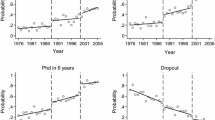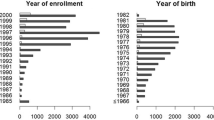Abstract
That PhD candidates fail to graduate on time in large numbers across a number of countries is a well-known fact. An extreme example is Estonia, where according to some estimates less than a third of PhD students complete their studies on time. A number of studies have addressed the likely reasons for such behavior, both comparatively and country-specifically, but empirical evidence is controversial and scant. To remedy the situation, we use the population data of Estonian doctoral students in order to explain the abysmal success rate. Findings suggest that student’s age and academic leave increase the probability to drop out. Contrary to the expectations, we find no evidence that drop out rates cluster around certain fields of studies. Furthermore, we argue that structural reasons supersede individual causes of failure and therefore instead of increasing the number of PhD positions to meet the demands of the labor market, the policy must incentivize doctoral candidates to stay fully engaged in their studies and subsequently graduate within nominal time limits. Our findings have profound implications regarding the higher education policy.


Similar content being viewed by others
Notes
“Development of a complex measures for Strengthening doctoral studies in Estonia (2003–2004)” funded by European Union Phare program and “Assurance system for quality, effectiveness and sustainability of doctoral studies in Estonian universities (2005–2008)” funded by the European Social Fund.
Immediate demand for a number that equals 2–3 years of total yearly supply of PhDs at the current graduation rate (Puura 2008, 49).
One can prolong the study period for 1 year only, after which the student is no longer eligible for academic leave.
Henceforth referred to as EHIS (http://www.ehis.ee/).
Notice, that the EHIS data lacks other relevant variables that may account for failure on the individual level, e.g., employment status, socio-economic background, etc. To some degree the omitted variable bias is accounted for by controlling for several system level characteristics. Moreover, as we recognize the issue of omitted variables we also exercise caution in our subsequent interpretation of the findings.
Academic leave may be potentially endogenous with regard to the dependent variable. However, since there is variance in failure across all of the categories of the academic leave taken, like somebody taking 2 years of academic leave but still graduating in 5 years, it was decided to keep it in the models.
References
Bowen, W. G., & Rudenstine, N. L. (1992). In pursuit of the Ph.D. Princeton, NJ: Princeton University Press.
Cantwell, R., Archer, J., & Bourke, S. (2001). A comparison of the academic experiences and achievement of university students entering by traditional and non-traditional means. Assessment & Evaluation in Higher Education, 26(3), 221–234.
Cassuto, L. (2010). The dissertation student who won’t finish. Chronicle of Higher Education, 57(7), A47–A49.
Clegg, S. (1997). A case study of accredited training for research awards supervisors through reflective practice. Higher Education, 34(4), 483–498.
Cumming, J. (2010). Doctoral enterprise: A holistic conception of evolving practices and arrangements. Studies in Higher Education, 35(1), 25–39.
Eamets, R. (2007). Ülevaade doktorite vajadusest eesti riigiasutustes ning erasektoris. In V. Puura, A. Kärner, E. Voolaid, & M. Saluveer (Eds.), Assurance system for quality, effectiveness and sustainability of doctoral studies in Estonian universities: Presentations and papers III (pp. 32–40). Estonia: Tartu University Press.
Eamets, R., & Masso, J. (2006). Doktorikraadiga inimeste vajadusest akadeemilises sektoris. In V. Puura, A. Kärner, E. Voolaid, & M. Saluveer (Eds.), Assurance system for quality, effectiveness and sustainability of doctoral studies in Estonian universities: Presentations and papers II (pp. 156–174). Estonia: Tartu University Press.
Ehrenberg, R., Zuckerman, H., Groen, J., & Brucker, S. (2009). How to help graduate students reach their destination. Chronicle of Higher Education, 56(8), A38.
Gardner, S. (2009). Student and faculty attributions of attrition in high and low completing doctoral programs in the United States. Higher Education, 58(1), 97–112.
Golde, C. (2006). The role of the department and discipline in doctoral student attrition: Lessons from four departments. Journal of Higher Education, 76(6), 669–700.
Kärner, A. (2004). Doktorandid Eesti ülikoolide doktoriõppest. In V. Puura, T. Lehtsaar, & A. Kärner (Eds.), Meetmete kogumi väljatöötamine doktoriõppe tugevdamiseks Eestis (pp. 46–54). Estonia: Tartu University Press.
Kärner, A. (2006). Doktoriõppe osapooled tulemuslikkuse parandamise võimalustest. In V. Puura, A. Kärner, E. Voolaid, & M. Saluveer (Eds.), Assurance system for quality, effectiveness and sustainability of doctoral studies in Estonian universities: presentations and papers II (pp. 137–155). Estonia: Tartu University Press.
Kärner, A. (2008). Doctoral supervision: New concepts and dilemmas. In J. Mikk, M. Veisson, & P. Luik (Eds.), Reforms and innovations in Estonian education (pp. 61–76). Bern: Peter Lang Publishing.
Kärner, A. (2009). Supervision and research training within the professional research community: Seeking new challenges of doctoral education in Estonia. PhD thesis, University of Tartu.
Kärner, A., Kukemelk, H., & Herdlein, R. (2005). Motivation for obtaining the doctor of philosophy degree in the post-soviet era: The case of Estonia. International Education, 35(1), 24–35.
Kearns, H., Gardiner, M., & Marshall, K. (2008). Innovation in PhD completion: The hardy shall succeed (and be happy!). Higher Education Research & Development, 27(1), 77–89.
Kraut, L. (2005). Kõrghariduse omandanute ja õpingud katkestanute võrdlus töötasult laekunud tulumaksu põhjal. Poliitikauuringute keskus PRAXIS. Available at: http://www.hm.ee/index.php?048183. Accessed April 13 2011.
Martin, A. J., Marsh, H. W., Williamson, A., & Debus, R. L. (2003). Self-handicapping, defensive pessimism and goal orientation: A qualitative study of university students. Journal of Educational Psychology, 95(3), 617–628.
Masso, J., Eamets, R., & Kanep, H. (2007). Estimating the need for PhDs in the academic sector via a survey of employers. University of Tartu Faculty of Economics and Business Administration Working Paper Series, 5(59), 3–77.
Meriküll, J., Eamets, R., & Masso, J. (2007). Doktorikraadiga tööjõu vajadus eesti erasektoris. In V. Puura, A. Kärner, E. Voolaid, & M. Saluveer (Eds.), Assurance system for quality, effectiveness and sustainability of doctoral studies in Estonian universities: Presentations and papers III (pp. 157–178). Estonia: Tartu University Press.
Murphy, N., Bain, J., & Conrad, L. (2007). Orientations to research higher degree supervision. Higher Education, 53(2), 209–234.
Neumann, R., & Rodwell, J. (2009). The ‘invisible’ part-time research students: a case study of satisfaction and completion. Studies in Higher Education, 34(1), 55–68.
Nicholls, M. (2007). Assessing the progress and the underlying nature of the flows of doctoral and master degree candidates using absorbing Markov chains. Higher Education, 53(6), 769–790.
Onwuegbuzie, A. J. (2004). Academic procrastination and statistics anxiety. Assessment and Evaluation in Higher Education, 29(1), 3–19.
Puura, V. (2008). Doktoriõpe ning sünergia Euroopa kõrgharidus- ja teadusruumi vahel. In A. Valk (Ed.) Bologna protsess Eestis 2004–2008 (pp. 49–53). SA Archimedes.
Rabe-Hesketh, S. & Skrondal, A. (2008). Multilevel and longitudinal modeling using Stata. Stata Corp.
Riigikantselei (2011). Valitsuse poliitikate arendamise peamised väljakutsed. Raport. http://bit.ly/i7QSuq. Accessed April 8 2011.
Seagram, B. C., Gould, J., & Pyke, S. W. (1998). An investigation of gender and ohter variables on time to completion of doctoral degrees. Research in Higher Education, 39(3), 319–335.
Sheridan, P. M., & Pyke, S. W. (1994). Predictors of time to completion of graduate degrees. Canadian Journal of Higher Education, 24(2), 68–87.
State Gazette (2006). Eesti kõrgharidusstrateegia aastateks 2006-2015 heakskiitmine. Available at: http://www.riigiteataja.ee/akt/12752949. Accessed April 14 2011.
Tiit, E., Paats, M., & Kaarna, K. (2008). Doktorite karjääriuuringust. Monthly Bulletin of Estonian Statistics, 3, 132–142.
Tones, M., Fraser, J., Elder, R., & White, K. (2009). Supporting mature-aged students from a low socioeconomic background. Higher Education, 58(4), 505–529.
Varblane, U. (2007). Struktuurimuutused eesti majanduses loovad doktorikraadiga töötajate struktuurimuutused eesti majanduses loovad doktorikraadiga töötajate vajaduse. In V. Puura, A. Kärner, E. Voolaid, & M. Saluveer (Eds.), Assurance system for quality, effectiveness and sustainability of doctoral studies in Estonian universities: Presentations and papers III (pp. 70–82). Estonia: Tartu University Press.
Visser, M. S., Luwel, M., & Moed, H. F. (2007). The attainment of doctoral degrees at Flemish Universities: A survival analysis. Higher Education, 54(5), 741–757.
Wright, T., & Cochrane, R. (2000). Factors influencing successful submission of PhD theses. Studies in Higher Education, 25(2), 181–195.
Acknowledgments
We wish to thank Rune Andersen, Piret Ehin, Kristian N. Nielsen, Marko Mölder, Vello Pettai, Pille Pruulmann-Vengerfeldt, Karsten Staehr and Eve Tõnisson for their valuable comments on the earlier drafts of the manuscript. All remaining errors are ours.
Author information
Authors and Affiliations
Corresponding author
Appendix
Rights and permissions
About this article
Cite this article
Vassil, K., Solvak, M. When failing is the only option: explaining failure to finish PhDs in Estonia. High Educ 64, 503–516 (2012). https://doi.org/10.1007/s10734-012-9507-6
Published:
Issue Date:
DOI: https://doi.org/10.1007/s10734-012-9507-6




